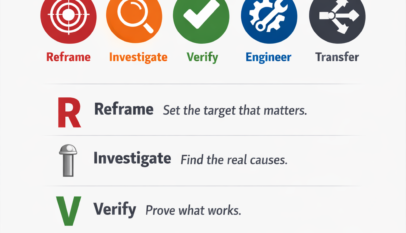How Lean Management Principles Can Help You Cut Costs and Enhance Customer Satisfaction
In today’s business world, companies always look for ways to improve their operations and stay ahead of the competition. One major challenge they face is managing growing costs effectively. In the past, businesses often increased prices to offset these costs, which could harm customer satisfaction and loyalty. Instead, this blog post will explore an alternative approach – using lean thinking and waste reduction to tackle rising costs while maintaining customer satisfaction. We will look at lean management principles and share real-world examples of companies that have successfully implemented this strategy.
The Traditional Thinking: I Make Consumers Pay
Traditionally, when faced with increasing costs, businesses would pass the burden onto their customers. This approach is often referred to as “cost-plus pricing,” where a company determines the price of its products by adding a fixed percentage margin to its costs (1). Although this strategy may help businesses maintain their profit margins in the short term, it can have long-term negative consequences. As prices increase, customers may become dissatisfied and seek more affordable alternatives, ultimately eroding the company’s market share and profitability.
The Lean Thinking: I Reduce Waste
Lean thinking is a philosophy and set of management principles that focus on the identification and elimination of waste in all aspects of a business (2). The term “lean” was first coined by James P. Womack and Daniel T. Jones in their seminal book “Lean Thinking: Banish Waste and Create Wealth in Your Corporation” (3). At its core, lean thinking aims to improve efficiency, reduce costs, and enhance customer satisfaction by streamlining processes and eliminating activities that do not add value to the end product.
The key principles of lean thinking include (4):
- Define value from the customer’s perspective: Understand and focus on providing your customer value.
- Identify the value stream: Map out the processes in delivering value to customers and eliminate non-value-added activities.
- Create flow: Ensure a smooth, uninterrupted flow of value through the value stream.
- Establish pull: Produce products based on customer demand rather than forecasting.
- Pursue perfection: Continuously improve processes and strive for the elimination of waste.
In managing costs, lean thinking encourages businesses to focus on reducing waste and improving efficiency rather than passing costs onto consumers. By streamlining processes and eliminating non-value-added activities, companies can cut costs, enhance customer satisfaction, and maintain their competitive edge.
Real-World Examples of Lean Thinking
Several companies have successfully adopted lean thinking and reaped its benefits. Some notable examples include:
- Toyota: The Toyota Production System (TPS), which is the foundation of lean thinking, has enabled Toyota to become one of the most efficient and successful automobile manufacturers in the world (5). By focusing on continuous improvement and waste elimination, Toyota has maintained high-quality products while keeping costs down.
- Nike: Nike implemented lean manufacturing practices in its factories to reduce waste, increase efficiency, and improve working conditions (6). As a result, the company has reduced its production lead times and increased its responsiveness to market demand, all while cutting costs.
- Intel: By embracing lean principles, Intel has reduced waste in its manufacturing processes, leading to significant cost savings and improved productivity (7).
Conclusion
In summary, lean thinking provides an alternative approach to managing cost increases, focusing on waste reduction and efficiency improvements rather than passing the burden onto consumers. By adopting lean principles, businesses can enhance customer satisfaction, maintain their competitive edge, and ultimately achieve long-term success. As demonstrated by companies like Toyota, Nike, and Intel, the benefits of embracing lean thinking are significant and wide-ranging. To effectively implement lean practices, businesses should focus on understanding customer value, identifying and eliminating waste in their value streams, and continuously pursuing perfection. By doing so, they can transform their operations, reduce costs, and maintain strong customer relationships without resorting to price hikes.
References:
(1) Anderson, S. (2016). Cost-Plus Pricing: The Dangerous Default. Retrieved from here
(2) Womack, J. P., & Jones, D. T. (2003). Lean Thinking: Banish Waste and Create Wealth in Your Corporation. Free Press.
(3) Liker, J. K. (2004). The Toyota Way: 14 Management Principles from the World’s Greatest Manufacturer. McGraw-Hill.
(4) Rother, M., & Shook, J. (1999). Learning to See: Value Stream Mapping to Add Value and Eliminate Muda. Lean Enterprise Institute.
(5) Ohno, T. (1988). Toyota Production System: Beyond Large-Scale Production. Productivity Press.
(6) Carty, M. (2013). Nike: How Lean Manufacturing Turns Into Green Manufacturing.
(7) Intel Corporation. (2018). Lean at Intel.


















